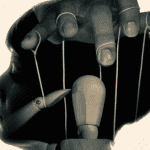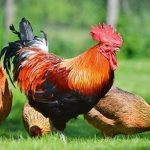 Weird Stuff
Weird Stuff  Weird Stuff
Weird Stuff  Our World
Our World 10 Ways Your Christmas Tree Is More Lit Than You Think
 Movies and TV
Movies and TV The 10 Coolest Stars to Set Sail on The Love Boat
 History
History 10 Things You Didn’t Know About the American National Anthem
 Technology
Technology Top 10 Everyday Tech Buzzwords That Hide a Darker Past
 Humans
Humans 10 Everyday Human Behaviors That Are Actually Survival Instincts
 Animals
Animals 10 Animals That Humiliated and Harmed Historical Leaders
 History
History 10 Most Influential Protests in Modern History
 Creepy
Creepy 10 More Representations of Death from Myth, Legend, and Folktale
 Technology
Technology 10 Scientific Breakthroughs of 2025 That’ll Change Everything
 Weird Stuff
Weird Stuff Ten Bizarre Facts About The Doge Meme
 Our World
Our World 10 Ways Your Christmas Tree Is More Lit Than You Think
 Movies and TV
Movies and TV The 10 Coolest Stars to Set Sail on The Love Boat
Who's Behind Listverse?

Jamie Frater
Head Editor
Jamie founded Listverse due to an insatiable desire to share fascinating, obscure, and bizarre facts. He has been a guest speaker on numerous national radio and television stations and is a five time published author.
More About Us History
History 10 Things You Didn’t Know About the American National Anthem
 Technology
Technology Top 10 Everyday Tech Buzzwords That Hide a Darker Past
 Humans
Humans 10 Everyday Human Behaviors That Are Actually Survival Instincts
 Animals
Animals 10 Animals That Humiliated and Harmed Historical Leaders
 History
History 10 Most Influential Protests in Modern History
 Creepy
Creepy 10 More Representations of Death from Myth, Legend, and Folktale
 Technology
Technology 10 Scientific Breakthroughs of 2025 That’ll Change Everything
10 Conceptions of What Extraterrestrial Could Look Like
The demands of everyday life, in the form of natural stimuli, prompt the development of the various behavioral traits and physical structures of plants and animals. In trying to envision the appearance of extraterrestrial beings, scientists once turned to Earth’s fossil record. After all, it provided evidence as to how organisms had already evolved on this planet.
Likely, they supposed, evolution would have produced similar effects on the flora and fauna of the aliens’ worlds. Later, they understood that, while this assumption is generally valid, evolution had to adapt alien life to its planets’ environments, not to Earth’s.
This list explores ten conceptions of what extraterrestrial life could look like based on alien nature’s demands and evolution’s accommodations.
Related: 10 Weird Places Aliens Might Be Lurking
10 K2-18b Life
K2-18b, a planet 120 light years from Earth, may be covered by an ocean. The James Webb Telescope has discovered a “possible sign” of life there: an abundance of a molecule that, on Earth, is known to come from living organisms like algae.
If scientists eliminate “non-biological sources of the molecule,” it’s more likely that K2-18B may, in fact, harbor life, although it may not be intelligent life. If it is intelligent, though, NASA anticipates that the announcement of such a discovery would be, well, earth-shaking.[1]
9 Extraterrestrial Marine Life
Could the oceans beneath the frozen surfaces of Jupiter’s moons be home to alien life? That’s a question that the European Space Agency hopes to answer. It’s possible that the moons’ icy surfaces, shielding marine organisms against space’s radiation, and their “warm interiors” could allow life to survive.
The Space Agency will focus its Jupiter Icy Moons Explorer, or Juice, on Callisto, Europa, and Ganymede as the spacecraft’s 10 instruments map them and “peer below their frozen crusts,” allowing scientists to assess whether the moons provide life-support conditions.
If so, the life would probably be microbial, says Professor Andrew Knoll of Harvard University, since it would depend wholly on chemosynthesis for its energy.[2]
8 Microbes, Spores, or Humans
As Peter Fimrite reports, physicist Enrico Fermi suggests that if we do encounter extraterrestrials, they may be “alien microbes” that a civilization among the stars dispatched throughout the Milky Way” as a means of introducing “directed panspermia.”
Others, Femrite says, suggest that alien life forms might be inactive spores by which intelligent aliens reconnoiter our solar system to evaluate whether we Earthlings are “a threat [that needs] to be eliminated.”
Still, others contend that we may ourselves be extraterrestrials who were shot into space when our ancestors’ home planet was struck by a giant meteor.[3]
7 Xenobiology Museum Alien Portraits
The online, or virtual, Xenobiology Museum features alien life that is “imagined by a human, generated by AI.” The museum’s founder, xenobiologist Dr. Tanya Singh, explains that the images must be created according to specific guidelines based on established biological principles and the “specific challenges posed by studying aliens.”
More specifically, the images focus on the biological function of “body parts and features.” They are produced with the aliens’ environments in mind and are based on both “species’ physical and behavioral characteristics.” (LINK 5) It helps that the prompt’s specifications are precise and that image production is exacting. (LINK 6)
The museum features alien mammals, birds, reptiles, amphibians, fishes, anthropods, invertebrates, and, of course, “unclassified xenoforms.” The Skeleton Closet exhibit, for example, includes 50 skeletal structures that, to the human eye, look bizarre, indeed, whether because of triangular skulls trailing a serrated bony projection and a long, thin neck connecting the rest of the nightmarish skeleton or a set of bones that look as though they belonged to an animal that was half lizard and half armadillo.[4]
6 “Walking Plants”
The appearance of alien organisms would be restrained by the same constraints that nature places on Earth’s plants and animals. It’s unlikely that any will look like the green aliens that are, in some cases, still staples of science fiction novels. But, according to a BBC Science Focus article, biomechanical experts and astrobiologists suggest that extraterrestrials might resemble those featured in two cult documentaries that aired over 20 years ago: Natural History of an Alien (1198) and Alien Planet (2005).
One such conception envisions walking trees equipped by evolution “with beating hearts, or with feet to move to better positions as they compete for light and water.” An artist’s conception of the hybrid animal-plant shows a cluster of projecting protuberances, out of which grow clumps of vegetation. It walks on five spindly, root-like legs, one of which branches into two. Unlikely? Not if such developments were successful adaptations to the environmental stimuli of the creature’s environment.[5]
5 Furian “Gasbags”
The Natural History of an Alien was a BBC Natural History Unit and Discovery Channel production featuring a panel of scientists and other experts from various UK universities and NASA. The film dismisses the trope of humanoid aliens, positing, instead, a number of others that would be more likely to evolve in other forms.
Science writer and paleontologist Dougal Dixon introduces viewers to one such possible alien species, the “gasbags” of Furia, an imaginary world with a highly sulfurous atmosphere. Anchoring themselves to Furia with stalks grown from their undersides to a length of thousands of kilometers, the mushroom-shaped “barrage balloons,” or “gasbags,” are supported by gas generated by themselves. They obtain energy from the sun and reproduce by “rubbing against one another to exchange their genetic material.” The offspring bud from their parents. When their stalks have grown long enough to reach the planet, they detach, becoming independent.[6]
4 Groveback vs. Beach Quills
Alien Planet, also a Discovery Channel production, further speculates on the appearances of alien life forms, envisioning, among other incidents, a groveback’s encounter with a field of beach quills. Again, a panel of scientists and other experts comment on the footage.
Visiting the imaginary planet Darwin IV, an unmanned spaceship from Earth releases a pair of probes, Leonardo da Vinci, or “Leo,” and Isaac Newton, or “Ike,” to investigate the planet’s flora and fauna, if any. They discover several, including the five-story-tall groveback with a distinctive diamond-shaped head, diamond-shaped body, elephantine legs, and a “grove” of sharp spires projecting from its back. The groveback’s fate illustrates the narrator’s observation that “just walking on Darwin IV is a hazardous undertaking.”
Encountering a colony of beach quills, which launch an attack, the enormous animal screams in pain as hundreds, if not thousands, of quills deeply penetrate its hide. The groveback stumbles, crashing to the quill-littered ground, as the dart-like projectiles deliver a fatal dose of neurotoxin. Within seconds, the beach quills “consume the groveback alive.”[7]
3 Octomite
As Newsweek’s senior science reporter Pandora Dewan states, the University of Oxford researchers’ paper “Darwin’s aliens” indicates how the same models of evolution used to explain life on Earth could be used to speculate about life on other planets or, for that matter, Enceladus, one of Saturn’s moons. Its ocean contains phosphorus, an element that is critical for DNA and is also present in ATP (adenosine triphosphate).
According to the paper, one of the extraterrestrials on Enceladus, the octomite, resembles a “budding tardigrade on steroids.” It is comprised of a hierarchy of entities with aligned evolutionary interests, each part specializing in a specific task. The organism reproduces by budding.[8]
2 Venera’s Temmets
In his children’s book Alien Worlds, illustrator David Aguilar melds art and science to imagine how alien creatures might adapt to their environments. He explores this concept with reference to eight worlds. Each world and its life forms are informed by Earth’s history. Like others on this list, it rejects the view of humanoid aliens, convinced that, on other worlds, “we are going to find bizarre adaptations.”
His book depicts Beachrollers, Seapups, Coneheads, Cave Crawlers, Windcatchers, Arrowheads, Netserefs, and Temmets. He rendered the style of the last of these aliens “after an actual fossil, [the] Hallucinenia, a small worm with spikes on its backs and tentacles for legs.”
The Temmet’s large size fits with a low-gravity planet. Its proboscis sucks up lake water, and it finds its way with sonar instead of eyes. Its spikes emit acoustic signals that bounce off their surroundings, which explains the functions of the Temmet’s body parts.[9]
1 “C”
Oxford University researchers disagree that extraterrestrial organisms will necessarily follow the evolution pathways of Earthly plants and animals. Consequently, researcher Sam Levin says he and his colleagues used “evolutionary theory to make predictions independent of Earth’s details” and in consideration of aliens that are based on silicon, lack DNA, and “breathe nitrogen.”
The researchers conceived three aliens, labeling them “A,” “B,” and “C.” Each of them has a more complex level of adaptability than its predecessor in the sketch. “A” is a simple replicating molecule. “B” is a cell-like entity that would undergo natural selection despite its simplicity. “C” is an alien with many intricate parts working together and would likely undergo major transitions.
Indeed, a sketch of “C” shows it as having six stubby feet and an hourglass shape that ends in a circular top surrounded by tentacles. An umbrella-like appendage, growing from the center of its top, bears small circular growths from which short shoots radiate.[10]








